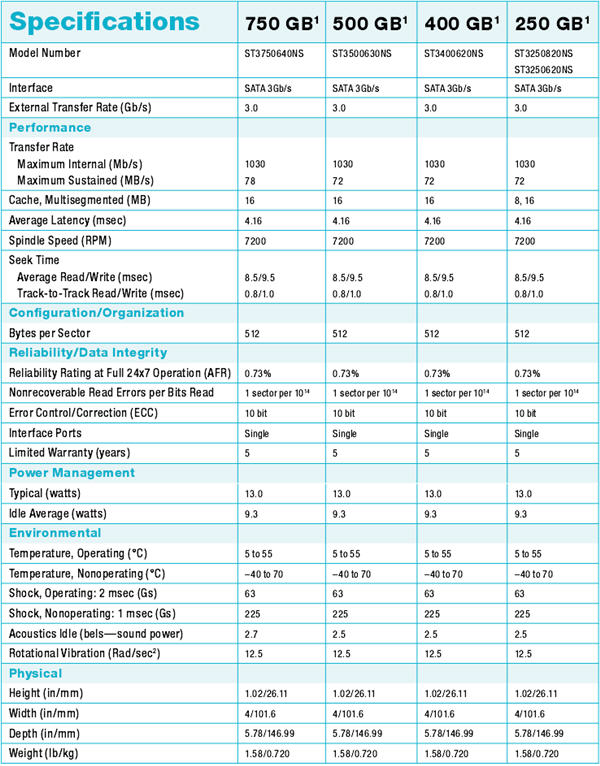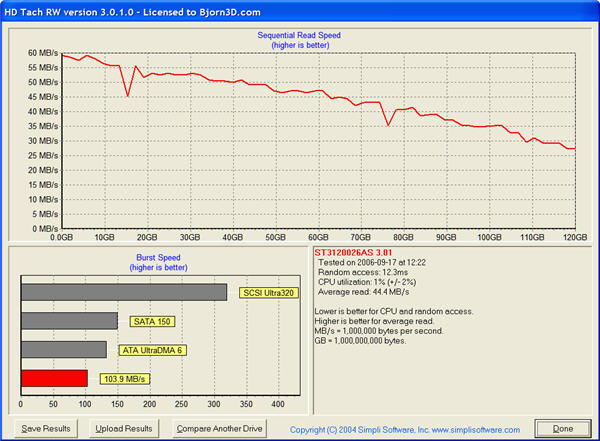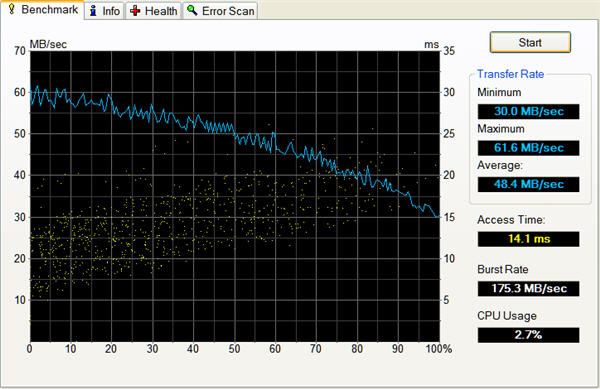Today we have the good fortune to the latest iteration of Seagate’s work, the 750GB Barracuda ES SATA drive, an enterprise level drive that boasts many new features. Please join me in the Bjorn3D lab where we fully intend to rigorously test this device with the intent of determining if the adorned title of being #1 transcended from Seagate the company into the production of this drive.
INTRODUCTION
Storage devices for the computer industry is one product line that would likely cause many of the founding fathers of modern day economic theory, production theory, and quality improvement methodology to rethink their wisdom. A bold statement? I don’t really think so, but allow me to elaborate. As with any industry there are peaks and valleys with regard to new products and their availability. This premise is also true when you look at supply and demand. The aspects we’re talking about here are the ever increasing need for more storage, smaller size with larger capacity, faster yet more stable drives, a significantly greater meantime between failure, and more rugged construction.
Each of these captioned aspects are while not overwhelming difficult to improve upon when you consider them individually. Unfortunately, the consumer demand focuses on all these aspects with an “I need it yesterday” mentality. Now back to my initial statement…the incredible or should I say should I say tumultuous thing about all of this is that the product manufacturers are meeting and in some cases exceeding this unyielding demand. I have been reviewing storage devices along with many other computer products for over five years now. During this time I’ve seen few if any of the other non-storage product manufacturers come even close to the speed, quality, and technology improvement demonstrated by the data storage industry.
Seagate, Inc. is rated by many of my proteges in computer product reviews as the number one manufacturer in the world of computer storage devices. Having reviewed many of their devices over the years and used their products in my own non-review specific computers, I must wholeheartedly concur with my peers. Seagate’s recent acquisition of Maxtor and their associated technology should only serve to strengthen this position in the market. All this being said, the evidence clearly points to Seagate being the best of the best.
Today we have the good fortune to the latest iteration of Seagate’s work, the 750GB Barracuda ES SATA drive, an enterprise level drive that boasts many new features. Please join me in the Bjorn3D lab where we fully intend to rigorously test this device with the intent of determining if the adorned title of being #1 transcended from Seagate the company into the production of this drive.

Seagate: A Brief Overview
Seagate was founded in 1979 and was the first company to build 5.25-inch hard disc drives for the PC. And while it may have seemed like a minor milestone at the time, today this hard disc drive introduction is regarded as one event that helped fuel the PC revolution. Suddenly, people could access unprecedented amounts of information, which eventually gave rise to the Internet and other developments. And for nearly a quarter of a century, Seagate has been developing the technology and manufacturing the products that helped make it all happen.
25 years later, the world runs on information. Every time you access the Internet, use an ATM, watch TV, listen to digital music, enjoy a movie with computer-generated special effects, or use a consumer-electronics device, you access and share large amounts of digital information on disc drives — the core of Seagate’s business.
Seagate also has its sights set years into the future. From hand-held computers and web phones, to intelligent storage that knows what information you want and when you want it, to home networks that deliver entertainment, education and services on demand — Seagate has the knowledge and resources to develop the technologies required for tomorrow. The company is committed to developing new solutions and technologies, pushing storage further than anyone could have imagined in 1979.
At the core of Seagate’s success is its advanced development of hard disc drive products. Seagate is the market leader with products in 1-inch, 2.5-inch and 3.5-inch form factors in internal and external formats. In capacities ranging from 2.5 gigabytes to 750 gigabytes, this comprehensive line includes products for the price-sensitive desktop market, consumer electronics devices (hand-held to in-home audio/video), pocket and portable storage, notebook computers and enterprise-class network servers.
THE DRIVE
When I unpacked this drive from it’s sturdy shipping container my first impression was not: “This is just another hard drive”. I had done my research prior to receiving the drive and knew it had not only the largest capacity currently available but many new and reputedly exciting features. My visual senses then took over and it appeared to be from this perspective to be identical in form to the Seagate NL-35 drive I reviewed a few months ago. The exciting thing that I relish about every new electronic product I review is that looks are very often deceiving.

Seagate Barracuda ES … Top View
Again the underside of the Barracuda ES from a visual point of reference mimicked it’s first cousin the NL-35.2 or maybe I just need new glasses.

Seagate Barracuda ES … Underside View
No changes in the power or SATA data connections either, but why should there be.

Power & SATA Data Connections
Note in the image above just to the right of the SATA data connector is a jumper block which allows the user to determine throughput of either 1.5 or 3.0 gigabits per second. The mechanically drawn image below better emphasizes this functionality, however the drawing is reversed from the actual layout.

FEATURES & SPECIFICATIONS
Time to go beyond my visual ineptness and look at an overview of the many new or enhanced features that the 750GB Barracuda ES SATA drive brings to the table.


Barracuda ES Product Line Features

Barracuda ES Product Line Specifications
Perpendicular Recording
The following information was detailed in our review of the Seagate 7200.10 750GB drive, but we feel it is essential to understanding the technology behind just how Seagate is able to produce a drive with 50% greater capacity than its competitors; so we decided to include it once again in this review as the same technology in an evolving state is being used with the Barracuda ES.
First, and foremost, how did Seagate increase the volume of their drives so radically? To answer that question we must first understand areal density. To paraphrase Webopedia’s definition: Areal Density also called bit density is the amount of data that can be packed onto a storage medium. Areal densities are generally measured in gigabits per square inch. The term is useful for comparing different types of media, such as magnetic disks and optical disks. Current magnetic and optical disks have areal densities of several gigabits per square inch.
Next we turned to Seagate for their technical comments on areal density: “To increase areal densities in longitudinal recording and boost overall storage capacity, the data bits must be shrunk and packed more closely together. However, if the bit becomes too small, the magnetic energy holding the bit in place may also become so small that thermal energy can cause it to demagnetize, a phenomenon known as superparamagnetism. To avoid superparamagnetism, disc media manufacturers have been increasing the coercivity (the field required to write a bit) of the media. However, the fields that can be applied are limited by the magnetic materials making up the write head.”
It would seem from that technical comment that areal density is approaching a limit in its expandability. We learned by reading further that a new process call “perpendicular recording” had been implemented to help augment the maximization of areal density. What is “perpendicular recording”? Even though we are pseudo geeks we had to rely on Seagate again to clarify that term: “In perpendicular recording, the magnetization of the disc, instead of lying in the disc’s plane as it does in longitudinal recording, stands on end, perpendicular to the plane of the disc. The bits are then represented as regions of upward or downward directed magnetization. (In longitudinal recording, the bit magnetization lies in the plane of the disc and flips between pointing in the same and opposite directions of the head movement.) The media is deposited on a soft magnetic under-layer that functions as part of the write field return path and effectively produces an image of the recording head that doubles the recording field, enabling higher recording density than with longitudinal recording.”

“Seagate has demonstrated a recording areal density with perpendicular recording of 245 Gbpsi (Gigabits per square inch) with a data rate of 480 Mbits per second – more than double the 110 Gbpsi used in today’s highest areal density disc drives – and 500 Gbpsi, which will increase the capacity of today’s drives 5-fold, is possible with the new technology. At 500 Gbpsi, a 3.5-inch disc drive could store two terabytes of information, a 2.5-inch drive in a laptop could hold 500GB and a 1-inch drive, such as those in MP3 players, could store as much as 50GB of data. This explanation, although somewhat simplified, not only answers our questions regarding the radical increase in capacity; but also the noticeable speed increases with each new drive. Ain’t technology just grand?
TESTING
Test System
- Asus P5WDG2 WS Professional Motherboard
- Intel E6600 Core 2 Duo (Conroe) Processor at default speed
- 2GB of Mushkin Redline XP2-8000 DDR-2 (4-5-4-11-1T @ 2.0 volts)
- LeadTek WinFast PX7950 GX2 TDH running ForceWare 91.47 drivers
- Test Drive 1: Seagate 750GB Barracuda SATA drive
- Test Drive 2: Seagate 500GB Barracuda NL-35.2 drive
- Test Drive 3: Seagate 120GB Barracuda 7200.7 SATA drive
- Creative Audigy 4 Sound Card
- Corsair CMPSU-620HX 620 PSU
- Lian-Li G70 Case customized by Performance PCs
- Windows XP Pro SP2
- Samsung Syncmaster 213T 21.3″ LCD Monitor
Tests/Benchmarks
- PCMark 2005
- SANDRA 2007 Profesional
- HD TACH RW version 3.0.1.0
- ATTO Benchmark
- HD Tune version 2.52
Test Methodology
We decided to do a side by side comparison of the Seagate 750GB Barracuda SATA drive, the Seagate 500GB Barracuda NL-35.2 drive and the Seagate Barracuda 120GB, 7200.7 drive. We felt the NL-35.2 should be reasonably close in performance to the Barracuda ES and the 7200.7 would give us a fond remembrance of where we were just a short time ago. Each of the drives will be run at its fastest throughput speed: 3.0 gigabits/sec for the Barrrcuda ES and NL35.2 as opposed to 1.5 gigabits/sec for the 7200.7. Before running each benchmark we rebooted the test system to clear system caches and unload any unnecessary programs.
Sandra 2007 Benchmark
SiSoftware Sandra is a 32 and 64-bit Windows system analyser that includes benchmarking, testing and listing modules. It tries to go beyond other utilities to show you more of what is really going on under the hood so you draw comparisons at both a high and low-level in a single product.

It should be noted that we opted not to graph the Random Access Time portion of this test as all drives showed the same 7ms time.
TESTING cont.
HD Tach Quick Benchmark (8MB Zones)
HD TACH RW performs sequential read and write test on removable media and non-partitioned fixed disks. HD Tach RW is also capable of performing the sequential read and write tests on the entire disk instead of the small number of zones in the quick and long test. We opted to use the Quick (8MB) test and the long (32 MB) test in the sequential read mode only as sequential writes will be covered by other benchmarks.

Barracuda ES

Barracuda NL-35.2

Barracuda 7200.7
HD Tach Long Benchmark (32MB Zones)

Barracuda ES … Long Test

Barracuda NL35.2

Barracuda 7200.7
TESTING cont.
ATTO Bench32 Test
This area graphically displays the results of the benchmark test. The y-axis of the graph represents the transfer sizes in the selected range. The x-axis represents the transfer speeds in MB/sec. I/O speeds for each transfer size are also displayed textually to the right of the graph in kB/sec.

Barracuda ES

Barracuda NL35.2

Barracuda 7200.7
HD Tune Benchmark
The HD TUNE Benchmark measures the raw performance of the following parameters: Transfer Rate, Access Time, CPU Usage, and Burst Rate.

Barracuda ES

Barracuda NL35.2

Barracuda 7200.7
PCMark 2005 HD Suite
PCMark 2005 measures just about every performance feature on one’s computer, in our testing today we opted to use only the Hard Drive Suite of tests.

CONCLUSION
Well guys, it does not get much better than this! The included benchmarks indicate that truly show a hard drive’s power and speed the Seagate® 750GB Barracuda ES drive is a clear winner, in some cases the differences between the Cuda ES and the NL-35.2 are not staggering, but in other cases (those that truly matter) there is a huge incremental improvement in speed. I alluded in my review of the Seagate Nl-35.2 that “it would probably be the conduit to the next Seagate generation of drive.” Viola! The Seagate Barracuda Enterprise System (ES) 750GB drive is that next generation of drive.
Some questions to consider are:
I’m an Extreme Computer Enthusiast, is the Barracuda ES the best Seagate drive for my general use? Probably not unless you want the drive for a high-end, fault tolerant workstation running an extreme RAID configuration. I say this because of the price which is in the $450 – $500 USD range and not because of any deference to the drive itself which is quite a performer.
I’m running a small business server and need capacity and performance, should I remove this drive from my short list because it’s rated for an Enterprise type of configuration? Absolutely not, this drive is perfect for your needs as long as you can justify the price.
Ok, you’ve told me what the Barracuda ES is capable of and its short comings, namely price, where is this drive best suited? While not a complex question, I feel it justifies more than a simple answer. This is the fastest single drive I’ve ever had the pleasure to test, even faster that some of the early generation Western Digital® Raptor™. I cannot comment about their newer drives because I’ve never owned or tested one. The capacity is awesome, 50% greater than any other drive on the market today. I can highly recommend the Barracuda ES to any individual or company in the market for either a high-end workstation or server drive that needs the power, speed, endurance, and operational features that this product offers. It’s probably also an excellent choice for the Computer Enthusiast wanting one or more drives to backup their valuable data as the MTBF would suggest it has a surprising longevity. Let us not also not forget that like every other Seagate drive, these drives possess an amazing five year warranty. I must also mention this is the quietest Seagate drive I’ve ever tested, the spinup, read, and write are barely audible.
This review was both meant to both give a fair assessment of the Seagate Barracuda ES 750GB SATA drive drive and wet your whistle for more things yet to emerge. That’s right this is merely the beginning for this drive as it along with two of its twin brothers will be the featured storage system for a rather massive third part to the RAID: A Guide For All … Part 2 that I published back in March. I expect to publish the third part of this guide in late Fall or early Winter and plan to include only the top of the line RAID controller cards, these drives, and some adjunct software from the major manufacturers utilizing RAID 0, 1, 10, and 5 that are suitable for either a high-end workstation or a medium to large business server environment. I’ve already done some preliminary testing and believe me we’ve only begun to scratch the surface of this drive’s performance and capabilities. This will be a very extreme article and will be all about performance in the RAID arena. We intend to use benchmarks that are more in line with business but we’ll also throw in some general consumer related tests as well.
I would sincerely like to thank David.L.Szabados and his wonderful crew Seagate for supplying not only this drive, but two identical to it for the upcoming Part 3 of RAID: A Guide For All.
Pros:
+ 750GB of storage
+ Low CPU utilization in benchmark
+ 16MB cache
+ Better cost/GB ratio than SCSI
+ 5 year warranty
+ 3.0 gigabits/sec I/O threshold, with the option to decrease to 1.5 gigabits/sec
+ Perpendicular Recording technology
+ Error Control Recovery
+ Rotation Vibration Feed Forward
Cons:
– Price for general use is prohibitive
Final Score: 9.0 out of 10, and the coveted Bjorn3D Golden Bear Award
 Bjorn3D.com Bjorn3d.com – Satisfying Your Daily Tech Cravings Since 1996
Bjorn3D.com Bjorn3d.com – Satisfying Your Daily Tech Cravings Since 1996




